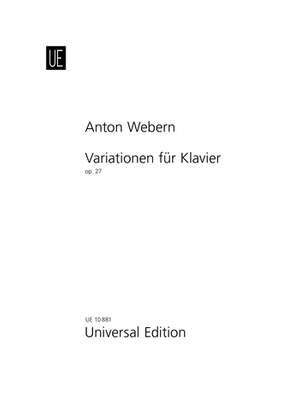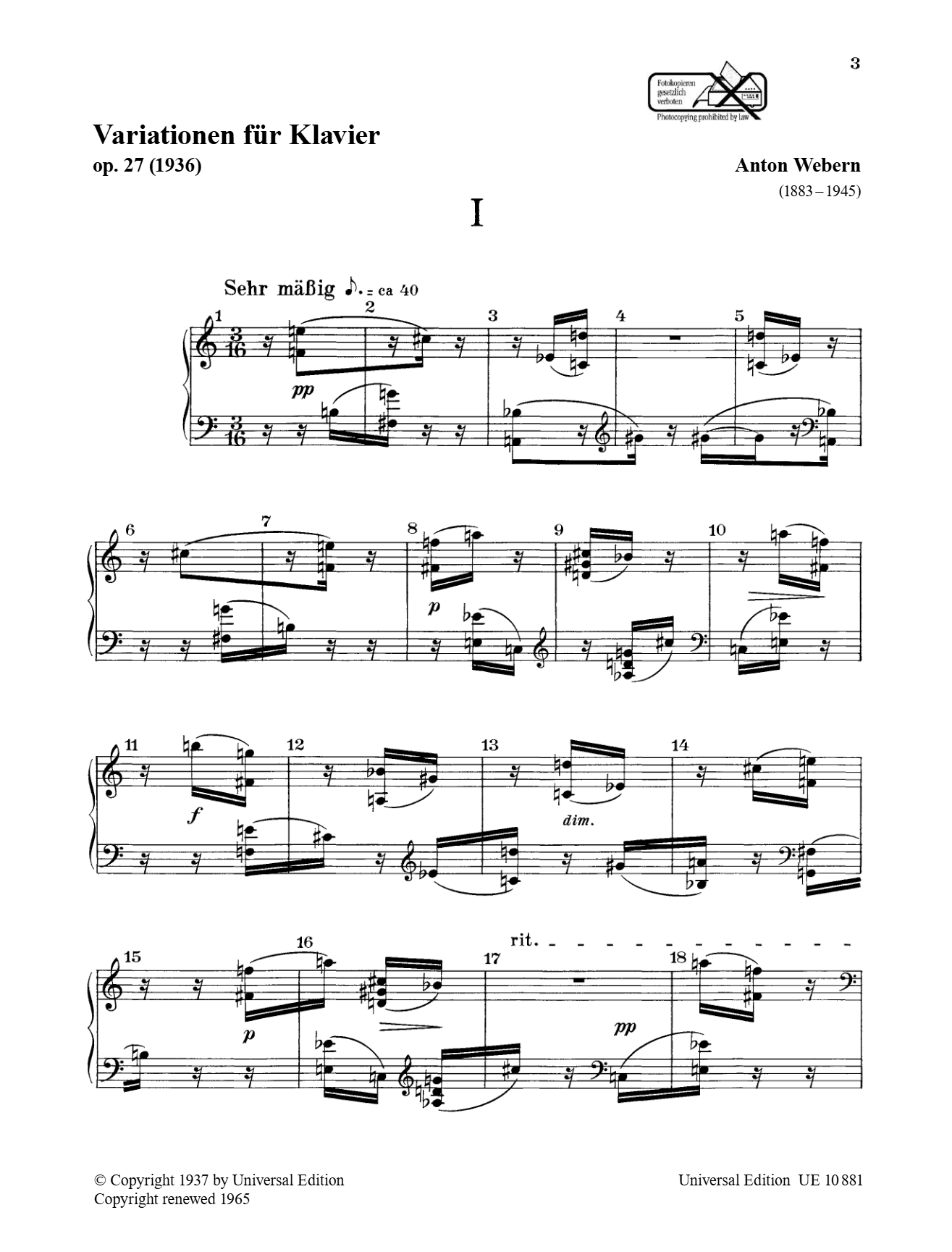
Happy Present Meet

[특가상품] Webern Variations Op.27 for Piano Solo
Contents
Variation I - Very moderate
Variation II - Very fast
Variation III - Quietly flowing
Webern dedicated this 1936 piano work to the pianist Eduard Steuermann, who had premiered almost all of the Viennese School's piano works since the 1910s and, along with the violinist Rudolf Kolisch, was instrumental in developing a new interpretive style appropriate to these complex compositions. The work is structured in three movements, quite unusual for variations, "a kind of suite" (Webern). The first two movements represent certain mirror formations of the series, which only becomes tangible as a theme in the third movement, the actual variations. The first section, a slow, clearly tripartite piece that has often been associated, not entirely unjustly, with Brahms's late intermezzi, consists exclusively of successive mirror phrases around a vertical axis; each section is arranged in a retrograde direction from the middle. For the listener, these phrases appear, for example, in the first seven bars, like antecedent-consequent relationships. The second, very fast movement, which Webern compared to Bach's Badinerie from the B minor overture, always presents two serial sequences simultaneously, the basic form and its inversion, thus simultaneously mirroring around a horizontal axis. These piano variations in particular, with their sparse piano writing punctuated by rests and their sparse playing directions, have often been misunderstood by music historians and performers alike as precursors to the punctuated music of the 1950s. However, the recollections of Peter Stadlen, who rehearsed the work with the composer himself for the Vienna premiere in 1937, are thought-provoking: "When he [Webern] sang and shouted, moved his arms and stamped his feet in an attempt to express what he called the meaning of the music, I was astonished to see that he treated the few, stand-alone notes as if they were cascades of sound." For the first twelve bars of the third movement (36 notes), Webern gave the following instructions: "elegiac, rushing, enthusiastic, pathetic, exalted, thoughtful, sweeping, exalted, quasi-vibrato, extinguishing." (Manfred Angerer)
베베른은 이 1936년 피아노 작품을 피아니스트 에두아르트 슈토이어만에게 헌정했습니다. 그는 1910년대 이후 빈 악파의 피아노 작품 거의 전부를 초연했으며, 바이올리니스트 루돌프 콜리쉬와 함께 이 복잡한 작품에 걸맞은 새로운 해석 양식을 개발하는 데 중요한 역할을 했습니다. 이 작품은 변주곡으로는 매우 이례적인 3악장으로 구성되어 있으며, "일종의 모음곡"(베베른)이라고 할 수 있습니다. 처음 두 악장은 이 시리즈의 거울상 형식을 보여주며, 이는 3악장, 즉 실제 변주곡에서야 비로소 주제로 구체화됩니다. 느리고 분명한 3부 구성의 첫 번째 부분은 종종 브람스의 후기 인테르메초와 연관되는데, 이는 전적으로 부당한 것은 아니지만, 수직축을 중심으로 연속적인 거울상 프레이즈로만 구성되어 있습니다. 각 부분은 중간에서 역행하는 방향으로 배열되어 있습니다. 예를 들어, 청취자에게 이러한 프레이즈는 처음 일곱 마디에서 선행-후행 관계처럼 나타납니다. 베베른이 바흐의 B단조 서곡 중 바디네리에 비유한 매우 빠른 두 번째 악장은 항상 기본 형식과 그 전위라는 두 가지 연속적인 시퀀스를 동시에 제시하며, 따라서 수평축을 중심으로 동시에 대칭을 이룹니다. 특히 쉼표로 구분된 드문 피아노 악보와 드문 연주 지시를 가진 이 피아노 변주곡들은 음악사가와 연주자 모두에게 1950년대 구두점 음악의 전조로 오해받는 경우가 많았습니다. 그러나 1937년 빈 초연을 위해 작곡가와 직접 이 작품을 연습했던 페터 슈타들렌의 회고록은 생각을 자극합니다. "베베른이 노래하고 소리치고 팔을 움직이고 발을 구르며 스스로 음악의 의미라고 부르는 것을 표현하려 했을 때, 나는 그가 몇 개의 독립적인 음표를 마치 소리의 폭포처럼 다루는 것을 보고 놀랐습니다." 3악장(36개 음표)의 처음 12마디에 대해 베베른은 다음과 같은 지시를 내렸습니다. "애가적이고, 급박하고, 열광적이고, 애수롭고, 고양되고, 사려 깊고, 휩쓸고, 고양되고, 준비브라토적이고, 소멸시키는" (만프레트 앙게러)
작곡가 Webern, Anton (1883-1945)

Bach Harpsichord Concerto No.5 in f minor BWV 1056 for 2 Piano 4 Hands
Scriabin Fantasy in b minor Op.28 for Piano Solo
[특가상품] ORCHESTRAL EXCERPTS for Bass Solo Vol.7
[특가상품] Schoenberg Verklarte Nacht Op.4 (Miniature Score)
[특가상품] Schoenberg Collected Songs for Voice and Piano Vol.2
[특가상품] Schoenberg 6 Orchestral Songs Op.8 for Voice and Piano
[특가상품] Schoenberg Das Buch Der Hangenden Garten Op.15 for Voice and Piano
[특가상품] Foote 2 Songs Op.59 for Soprano (Tenor), Violin and Piano
[특가상품] 50 Art Songs from the Modern Repertoire
[특가상품] Schoenberg Sonata Op.26 for Violin (or Flute) and Piano